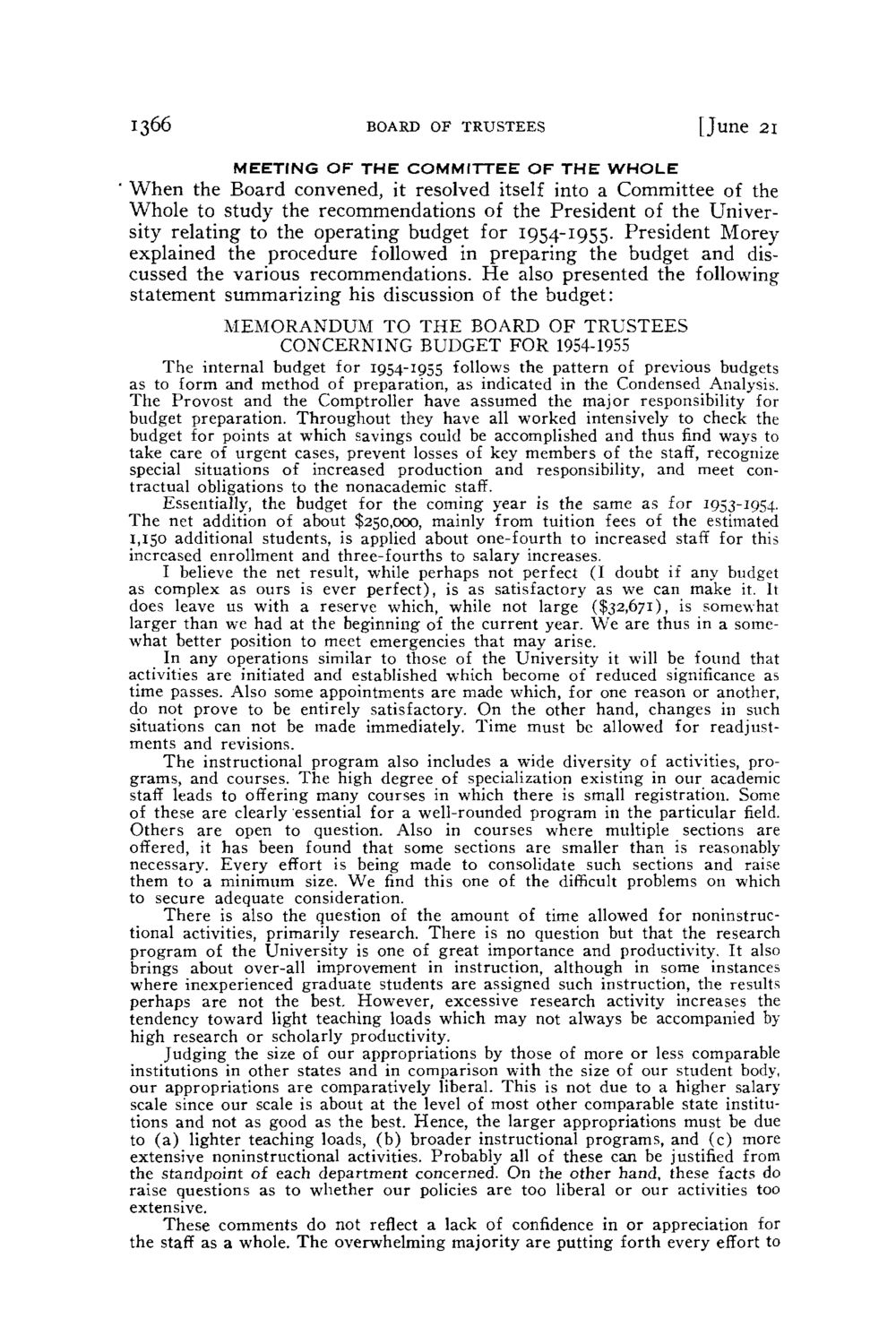| |
| |
Caption: Board of Trustees Minutes - 1954
This is a reduced-resolution page image for fast online browsing.

EXTRACTED TEXT FROM PAGE:
1366 BOARD OF TRUSTEES [June 21 MEETING O F T H E COMMITTEE OF T H E W H O L E ' When the Board convened, it resolved itself into a Committee of the Whole to study the recommendations of the President of the University relating to the operating budget for 1954-1955. President Morey explained the procedure followed in preparing the budget and discussed the various recommendations. He also presented the following statement summarizing his discussion of the budget: MEMORANDUM TO THE BOARD OF TRUSTEES CONCERNING BUDGET FOR 1954-1955 The internal budget for 1954-1955 follows the pattern of previous budgets as to form and method of preparation, as indicated in the Condensed Analysis. The Provost and the Comptroller have assumed the major responsibility for budget preparation. Throughout they have all worked intensively to check the budget for points at which savings could be accomplished and thus find ways to take care of urgent cases, prevent losses of key members of the staff, recognize special situations of increased production and responsibility, and meet contractual obligations to the nonacademic staff. Essentially, the budget for the coming year is the same as for 1053-1954. T h e net addition of about $250,000, mainly from tuition fees of the estimated 1,150 additional students, is applied about one-fourth to increased staff for this increased enrollment and three-fourths to salary increases. I believe the net result, while perhaps not perfect (I doubt if any budget as complex as ours is ever perfect), is as satisfactory as we can make it. It does leave us with a reserve which, while not large ($32,671), is somewhat larger than we had at the beginning of the current year. W e are thus in a somewhat better position to meet emergencies that may arise. In any operations similar to those of the University it will be found that activities are initiated and established which become of reduced significance as time passes. Also some appointments are made which, for one reason or another, do not prove to be entirely satisfactory. On the other hand, changes in such situations can not be made immediately. Time must be allowed for readjustments and revisions. T h e instructional program also includes a wide diversity of activities, programs, and courses. T h e high degree of specialization existing in our academic staff leads to offering many courses in which there is small registration. Some of these are clearly essential for a well-rounded program in the particular field. Others are open to question. Also in courses where multiple sections are offered, it has been found that some sections are smaller than is reasonably necessary. Every effort is being made to consolidate such sections and raise them to a minimum size. W e find this one of the difficult problems on which to secure adequate consideration. There is also the question of the amount of time allowed for noninstructional activities, primarily research. T h e r e is no question but that the research program of the University is one of great importance and productivity. It also brings about over-all improvement in instruction, although in some instances where inexperienced graduate students are assigned such instruction, the results perhaps are not the best. However, excessive research activity increases the tendency toward light teaching loads which may not always be accompanied by high research or scholarly productivity. Judging the size of our appropriations by those of more or less comparable institutions in other states and in comparison with the size of our student body, our appropriations are comparatively liberal. This is not due to a higher salary scale since our scale is about at the level of most other comparable state institutions and not as good as the best. Hence, the larger appropriations must be due to ( a ) lighter teaching loads, (b) broader instructional programs, and (c) more extensive noninstructional activities. Probably all of these can be justified from the standpoint of each department concerned. On the other hand, these facts do raise questions as to whether our policies are too liberal or our activities too extensive. These comments do not reflect a lack of confidence in or appreciation for the staff as a whole. T h e overwhelming majority are putting forth every effort to
| |